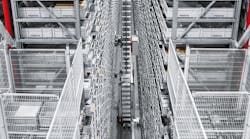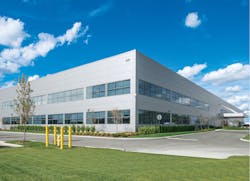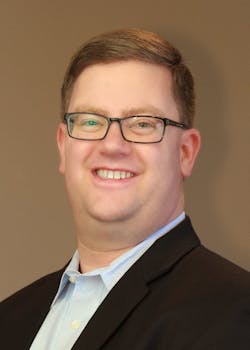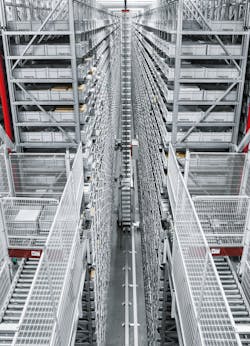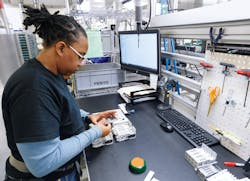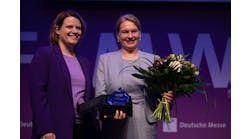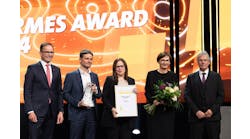Just down the road from Kings Island Amusement Park in Mason, Ohio, stands an equally exciting and impressive campus with state-of-the-art operations and logistics that rival any in the country. The Festo Regional Service Center employs 350 people and ships around 35 million pieces each year.
“Regional” is a relative term, in this case meaning the Americas, a fairly large region, so it’s no wonder the 526,000-sq-ft complex sits on a 47-acre campus (Figure 1).
Its location has facilitated swifter order fulfillment. “For inbound material, the Mason facility benefits from being driving distance from several major freight hub airports,” said Sean O’Grady, director of sales operations, who acted as my tour guide of Festo’s production and fulfillment hub. “Inbound sea freight shipments can also utilize any of the major east coast ports. For outbound material, a large majority of customers fall within the two-day ground delivery radius for Mason’s parcel carrier partners.”
Festo has also benefitted from a well-educated supply chain workforce in the Mason area, explained O’Grady. “Festo works closely with the University of Cincinnati’s Lindner College of Business, as well as other local schools to attract talent,” he said. “Festo offers co-op and internship opportunities for students at these institutions, many of whom have become major contributors to the company’s success.”
As director of sales operations, O’Grady wears many hats (Figure 2). “I started with Festo in 1996,” he explained. “It’s not simple to describe the constellations of responsibilities that I have, so I just say that I’m responsible for processes that help to align our sales and supply organizations.” Over the past quarter century, O’Grady has held multiple positions with Festo, including inside sales/technical support, applications engineer, national accounts project engineer, technical support manager, contact center manager, product manager and sales manager—Didactic Seminars.
The Festo complex comprises three buildings. The first houses logistics and production. The 230,000-sq-ft building was completed in 2015. In 2020, the second and third—an additional 188,000-sq-ft logistics building and a 108,000-sq-ft production building—were added.
The facility is home to a variety of operations, including logistics, training, assembly, manufacturing and product development.
Logistics includes material flow to and from the various production cells; replenishment of other Festo North American warehouses; replenishment orders for Festo’s distribution network; and direct order fulfilment for customer orders. Manufacturing and final assembly include catalog products and custom projects. Technical training is available for external customers through the Festo Didactic division. The training includes basic electricity, programmable-logic-controller (PLC) programming, fluid power, mechanical systems and a variety of other related topics.
A large part of the logistics and fulfillment are enabled by two automated storage and retrieval systems (AS/RS) and supporting software provided by Festo’s partner, Witron (Figure 3). “If the 208,000 storage locations, or bins, in the Witron AS/RS were lined up end to end, the line of bins would stretch about 35 miles—the distance between Mason and Dayton, Ohio,” explained O’Grady. The system is one contiguous unit defined by six automated receiving stations, nine automated picking stations, 17 automated packing stations, eight production interface conveyor stations and the 208,000 bins (Figure 4).
“Festo Mason differentiates between manufacturing catalog products and custom solutions,” explained O’Grady. “Some products, such as fittings and brackets, come as ready to sell. Festo focuses local manufacturing capability on catalog products, final assembly and testing. Examples include valve manifolds, air preparation assemblies, such as filter, regulator and lubricator (FRL), cylinders and drives.”
Festo differentiates between cylinders as pneumatic drives that have a traditional piston rod and drives that encompass both pneumatic and electrical components that don’t have a piston rod, explained O’Grady. “For the custom solutions business, Mason has a vast array of production and test technologies deployed,” he said. “Many of those assets are for specific customers and are confidential.”
Product development takes place in the Technical Engineering Center (TEC), which currently employs 12 people, with plans to expand to 17. “Three TEC projects are in the catalog,” noted O’Grady. “TEC should release around 10 catalog products per year when the total staff reaches 30 to 40 people.”
Festo Didactic is the company’s educational and training division. “Festo Didactic workforce development activities are conducted nationwide,” said O’Grady. “While the Mason facility does have a fully equipped learning center, most of the classes that Festo conducts for its customer partners take place at their sites across the country. Karolyn Ellingson, who manages this aspect of Didactic, is an experienced workforce-development professional and a member of both the Area 12 Workforce Development Board in Ohio and the National Association of Workforce Boards. She connects with customers through the Festo sales and distribution network and through the various non-government entities that are involved with closing the employment skills gap. Locally, Festo is proud of the career paths within the company that are supported by its training programs. Long careers, with many steps, are common at Festo.”
Festo’s continuous improvement programs consistently meet or exceed goals, reported O’Grady. “It’s important to understand that Festo is a family-owned $3 billion global business with a culture that fosters respect for the individual and individual growth,” he emphasized. “The Mason team responds to this cultural environment with exceptional dedication and creativity.”
